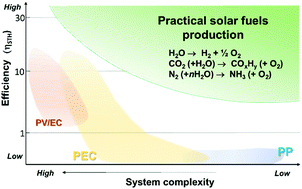Current density in solar fuel technologies
Abstract
Solar-to-fuel direct conversion devices are a key component to realize a full transition to a renewable-energy based chemistry and energy, but their limits and possibilities are still under large debate. In this review article, we focus on the current density as a fundamental figure of merit to analyse these aspects and to compare different device configurations and types of solar fuels produced from small molecules such as H2O, CO2 and N2. Devices with physical separation of the anodic and cathodic zones, photoelectrochemical-type (PEC) or with a photovoltaic element integrated in an electrochemical cell (PV/EC), are analysed. The physico-chemical mechanisms involved in device operation that affect the current density and relations with device architecture are first discussed. Aspects relevant to device design in relation to practical use are also commented on. Then discussion is moved towards the relevance of these aspects to compare the behaviour in the state-of-the-art of the conversion of these small molecules, with focus on solar fuels from H2O, CO2 and N2 conversion, highligthing the gaps and perspectives of such technologies. The still significant lack of crucial data, notwithstanding the extensive literature on the topic, has to be remarked on, particularly in terms of the need to operate these cells in conjunction with sun concentration (in the 50–100 sun range) which emerges as the necessary direction from this analysis, with consequent aspects in terms of cell and materials design to operate in these conditions. The work provides a guide for the optimisation of the investigated technology and the fixing of their practical limits for large-scale applications.

- This article is part of the themed collection: Energy and Environmental Science Recent Review Articles


 Please wait while we load your content...
Please wait while we load your content...